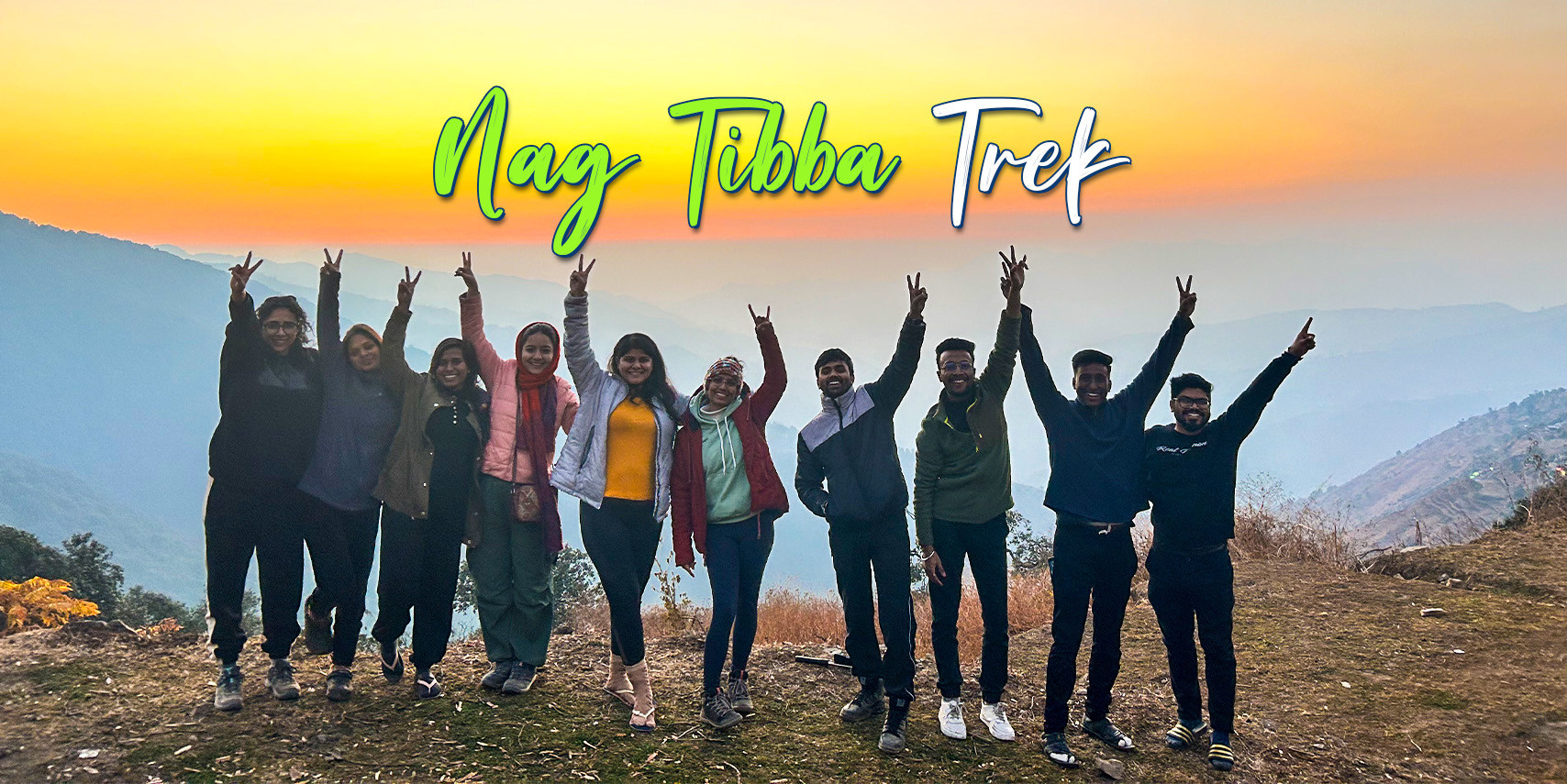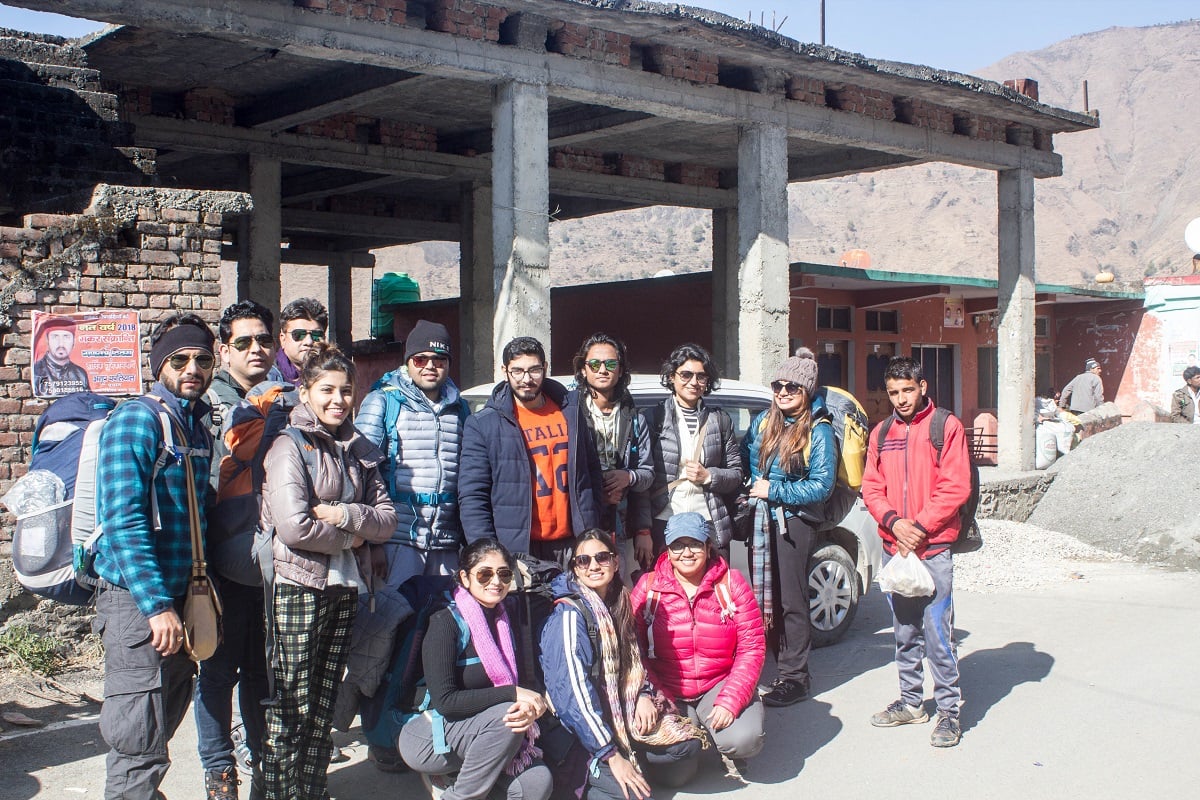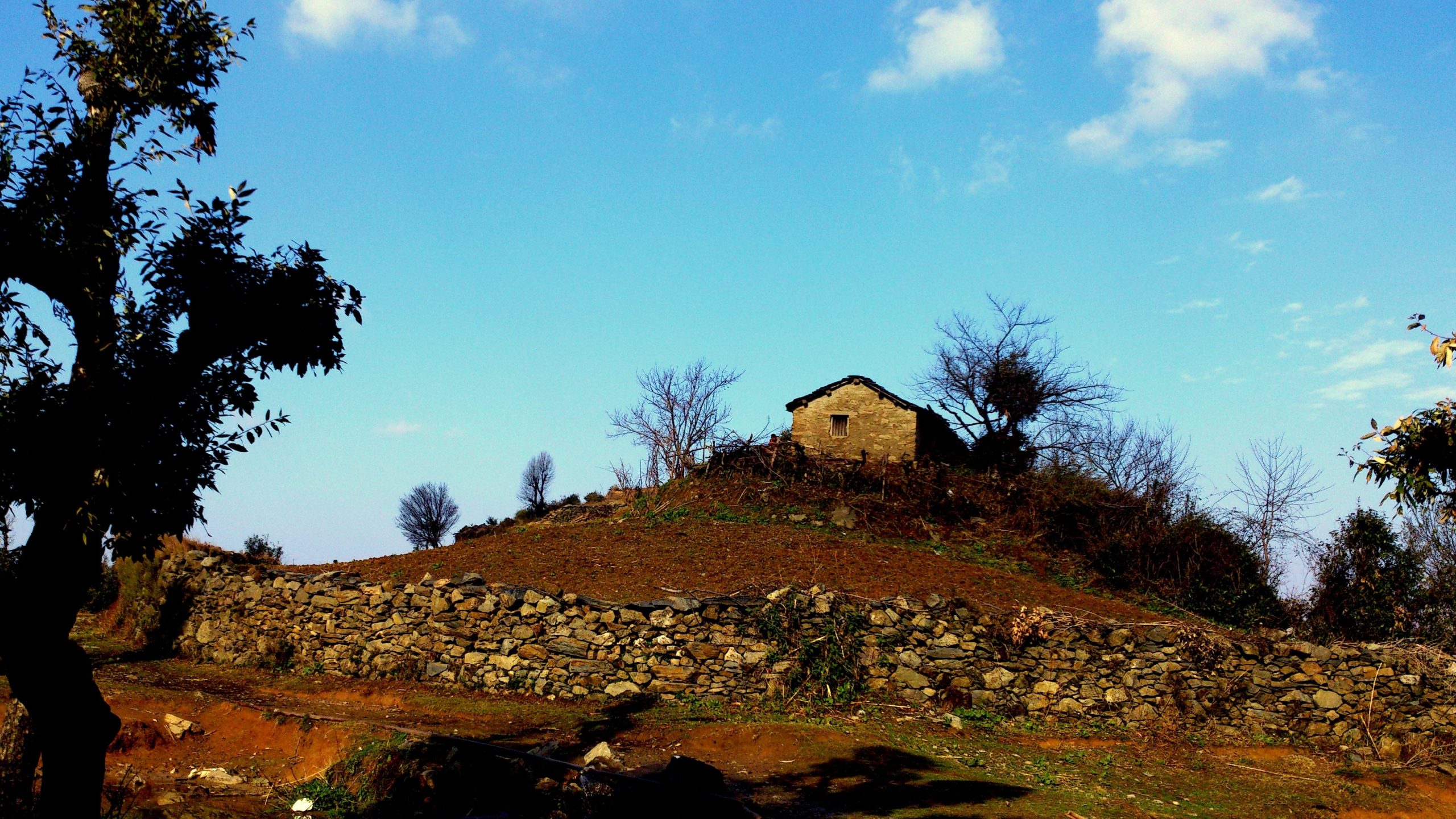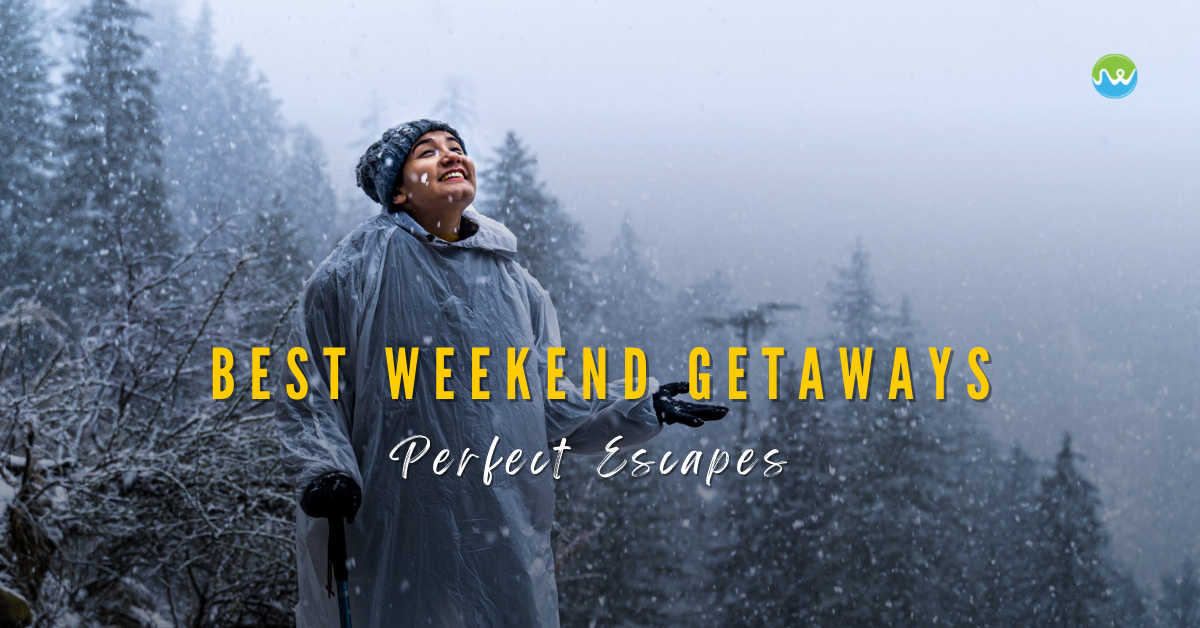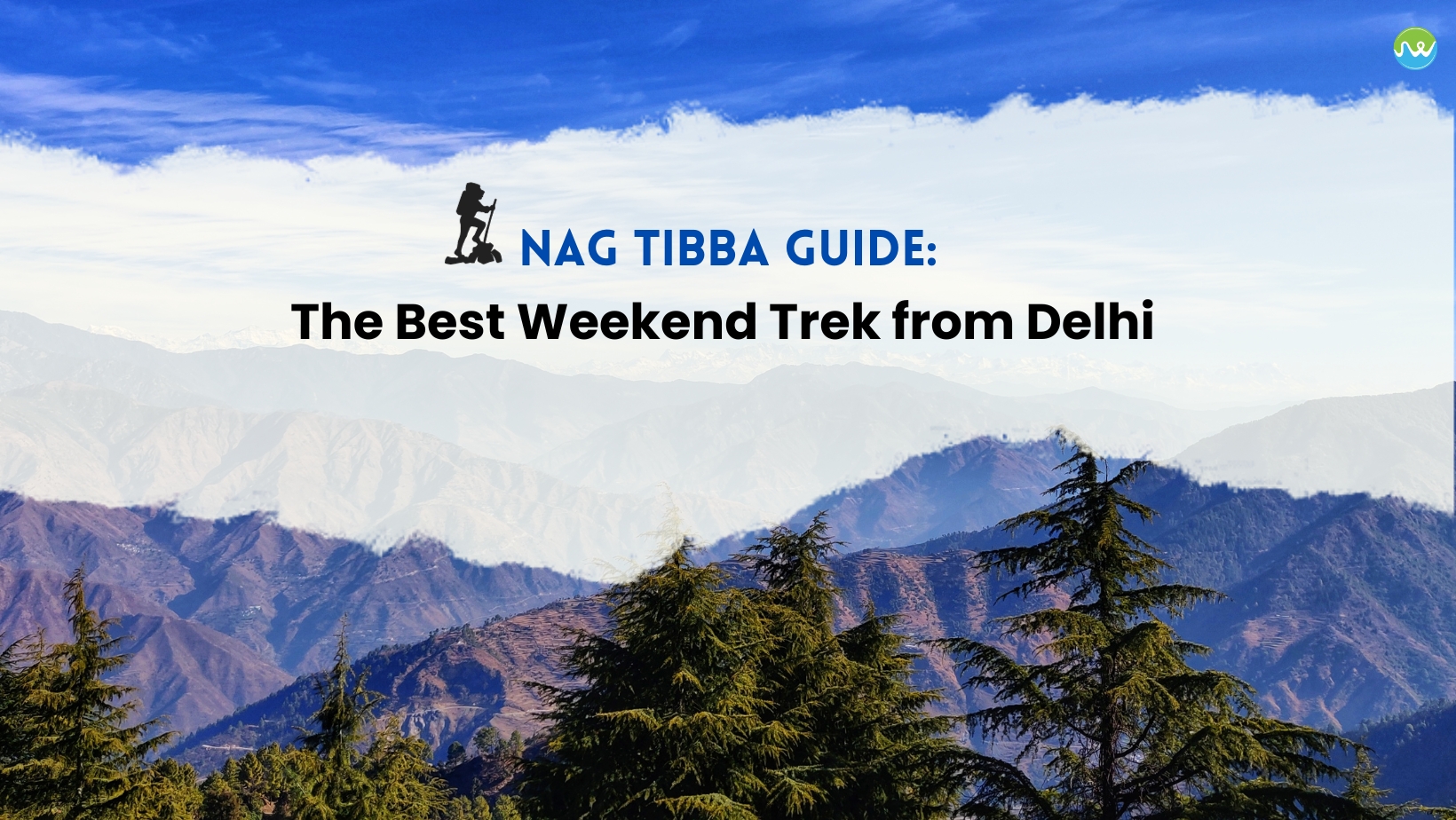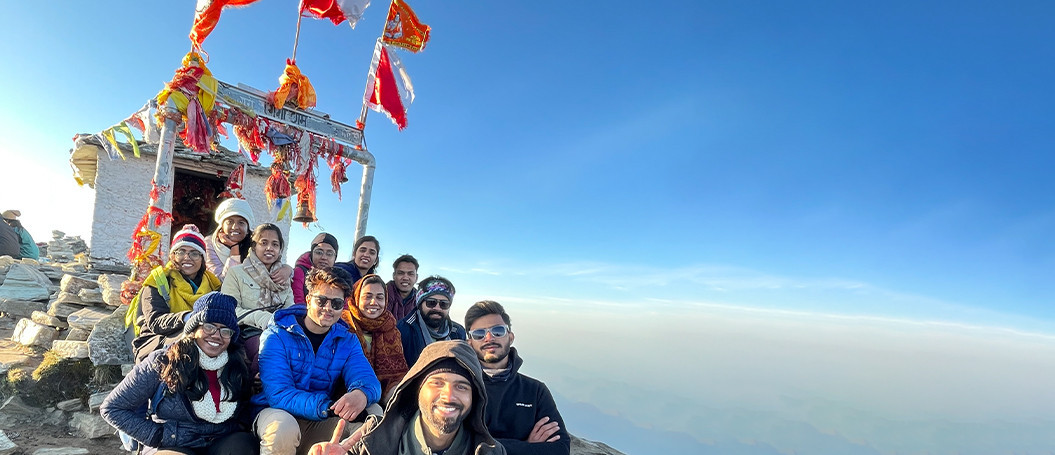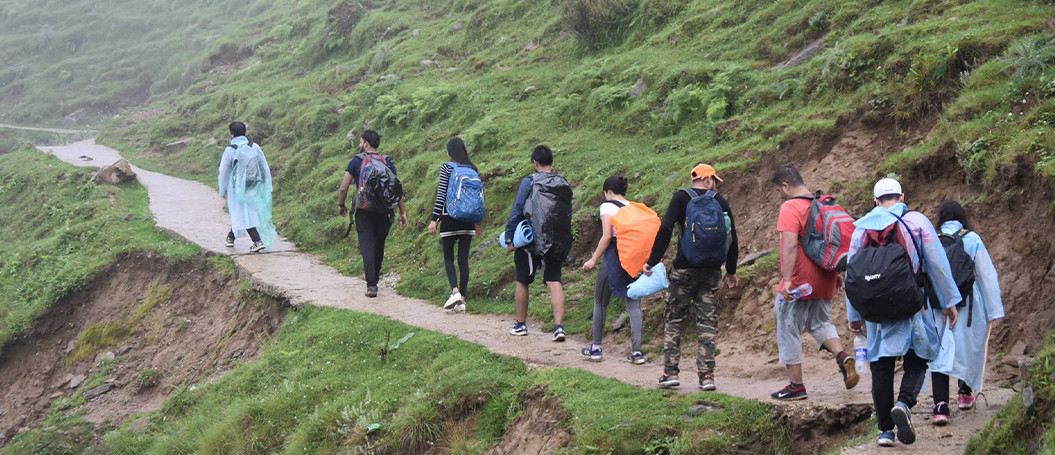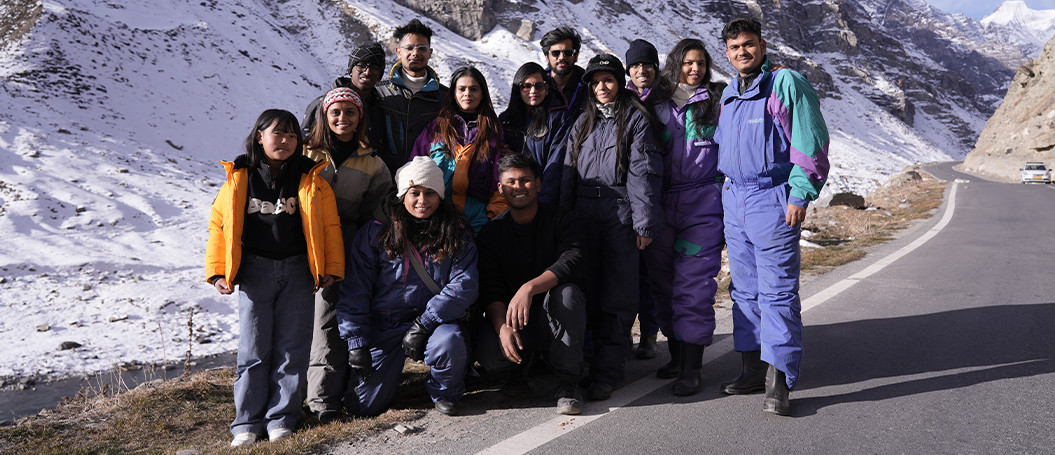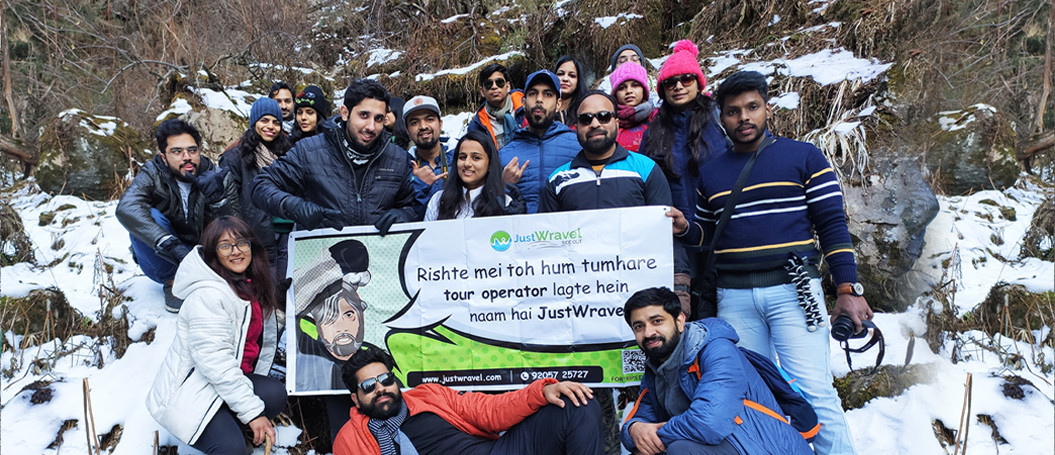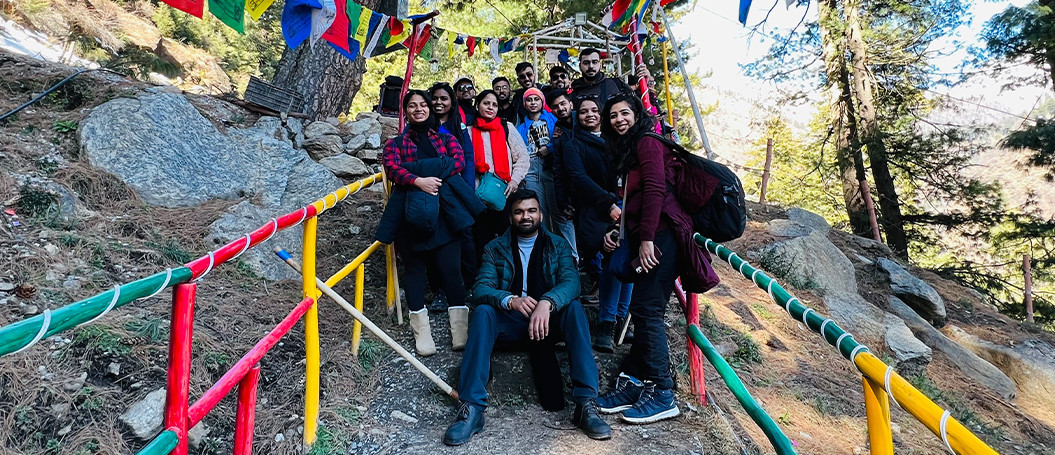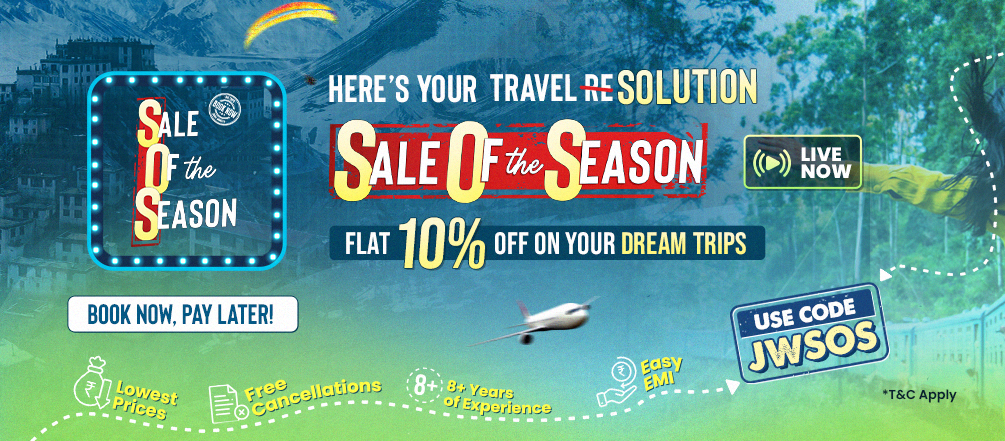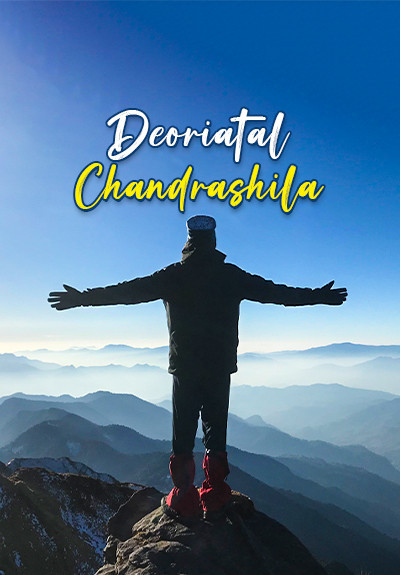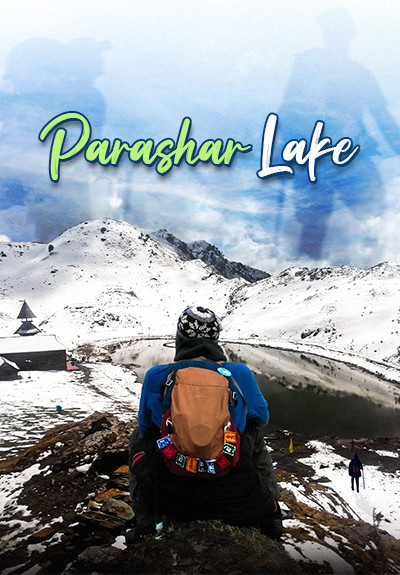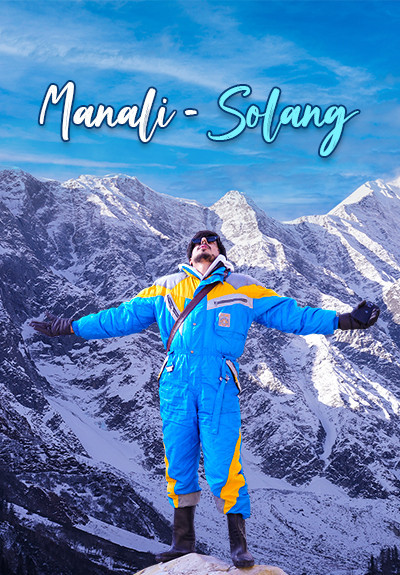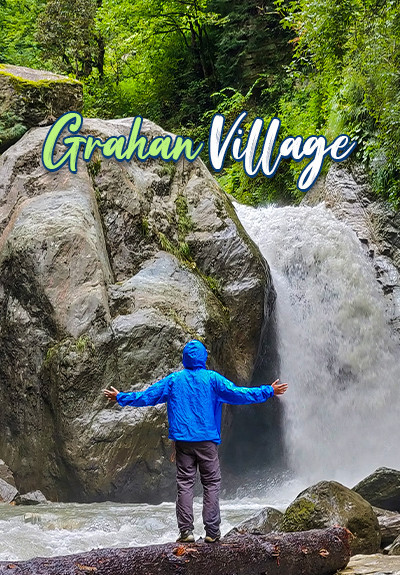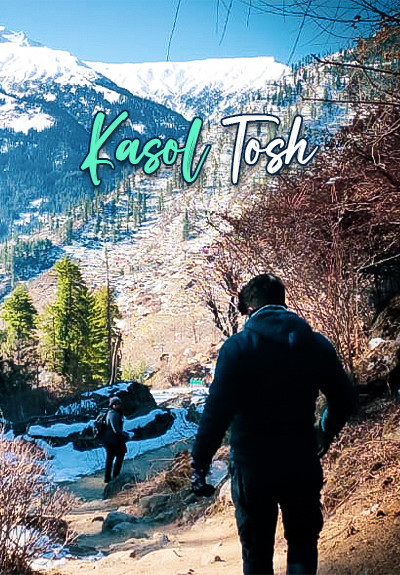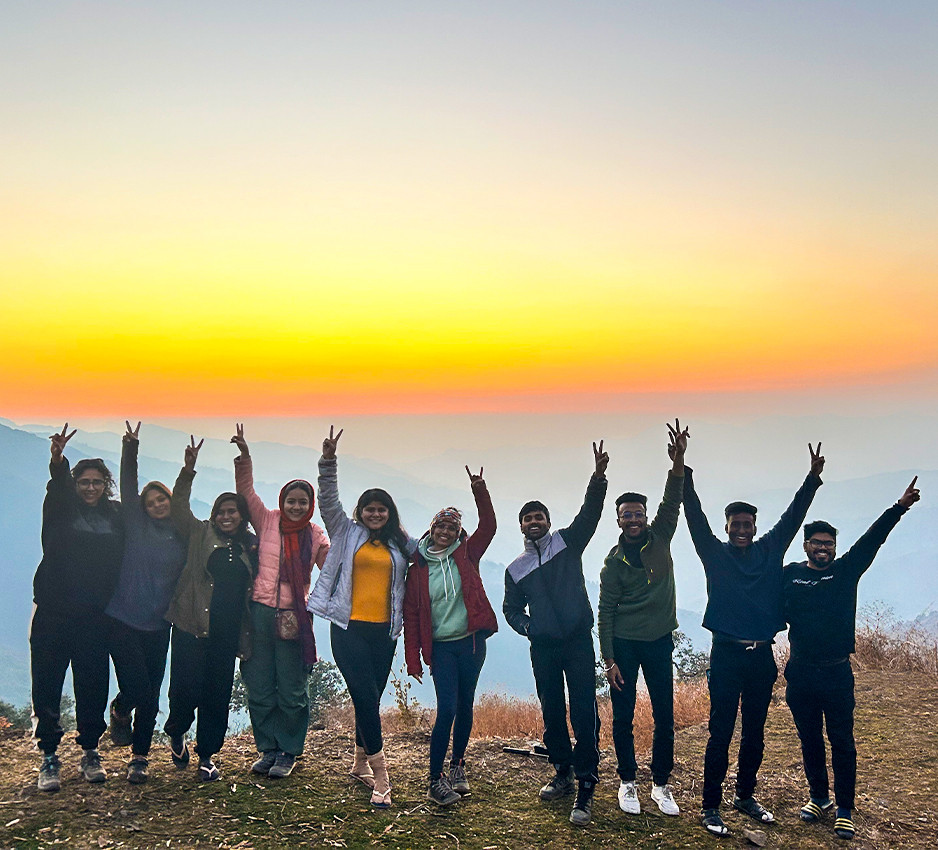
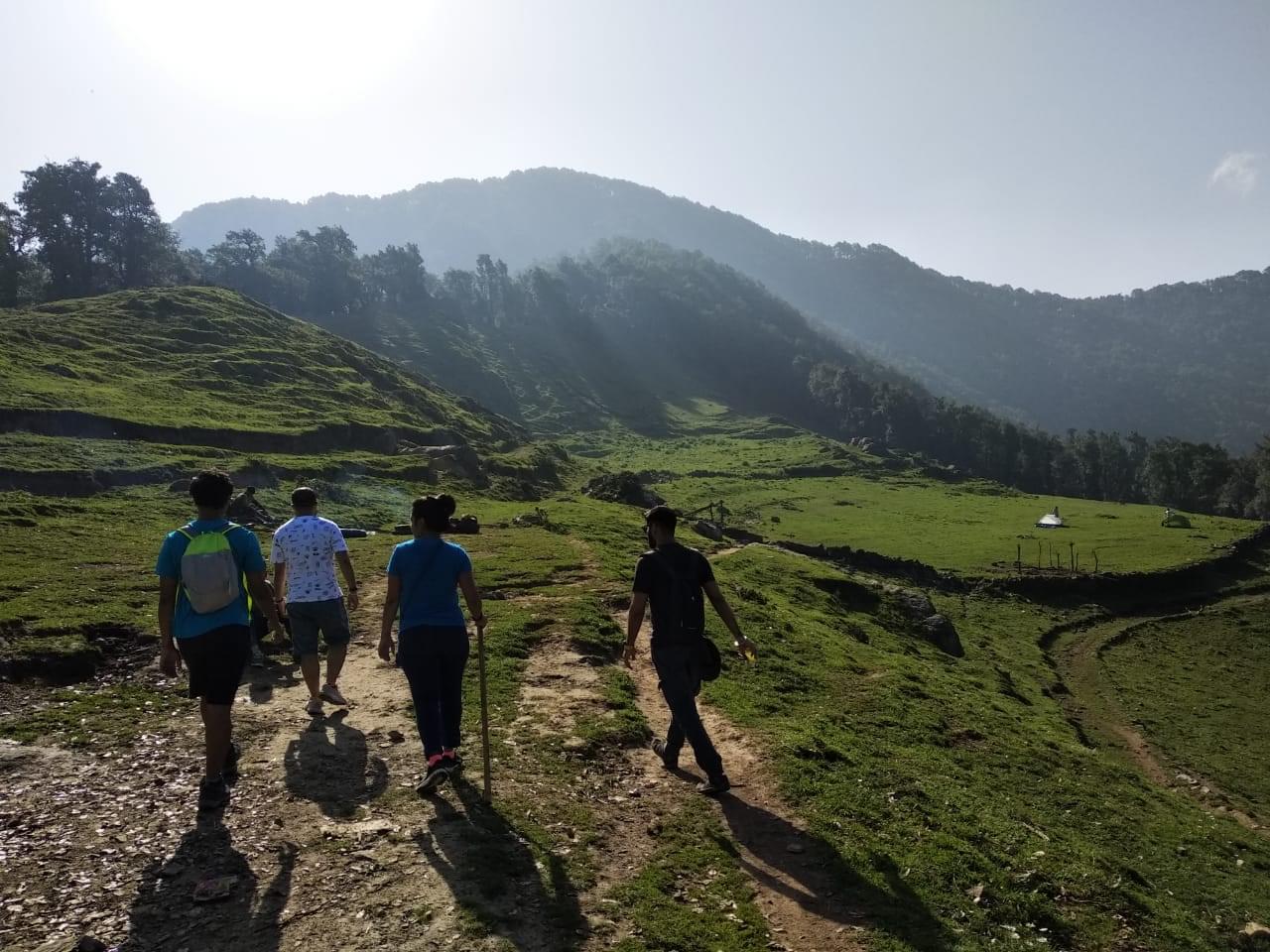
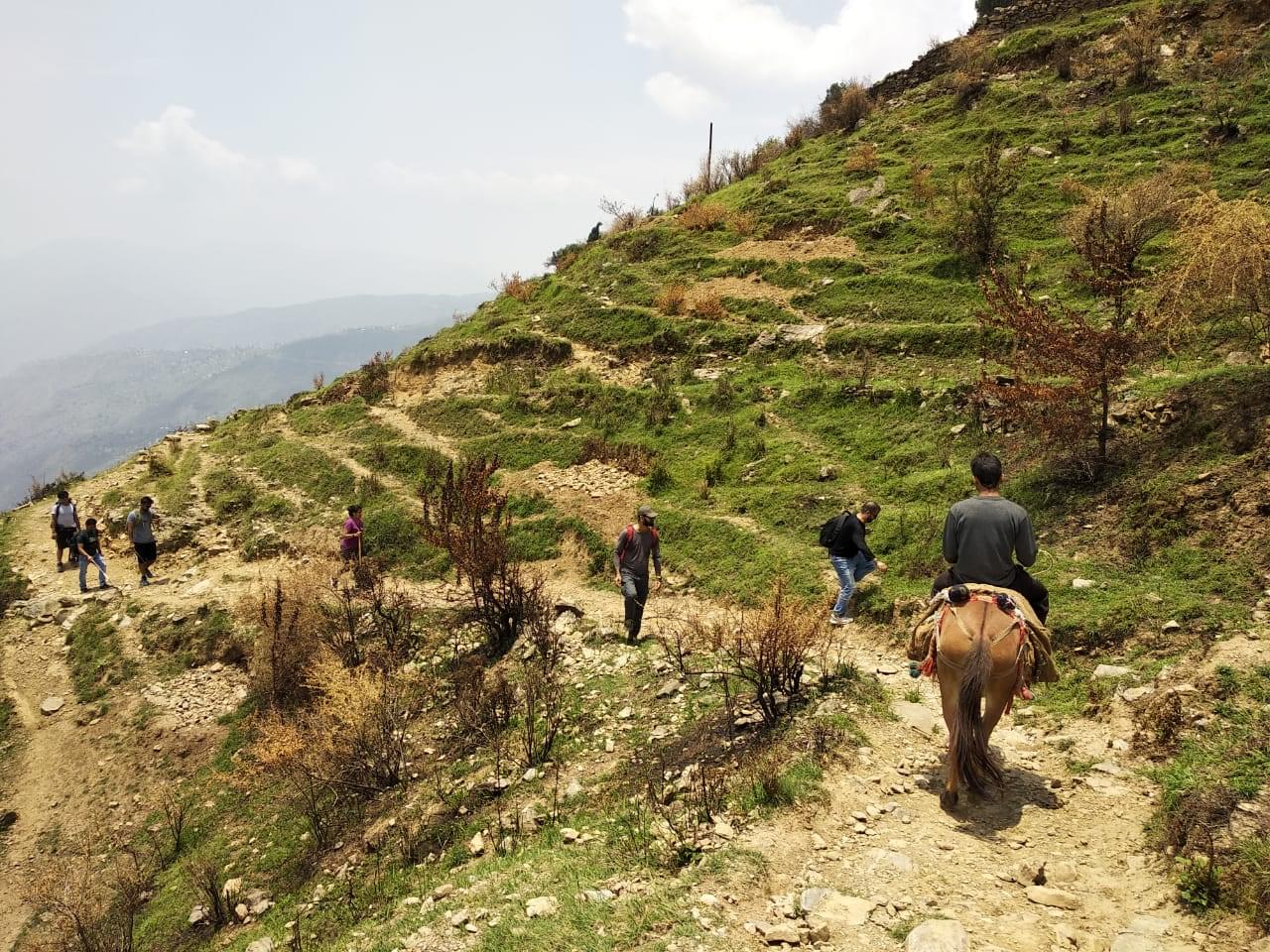
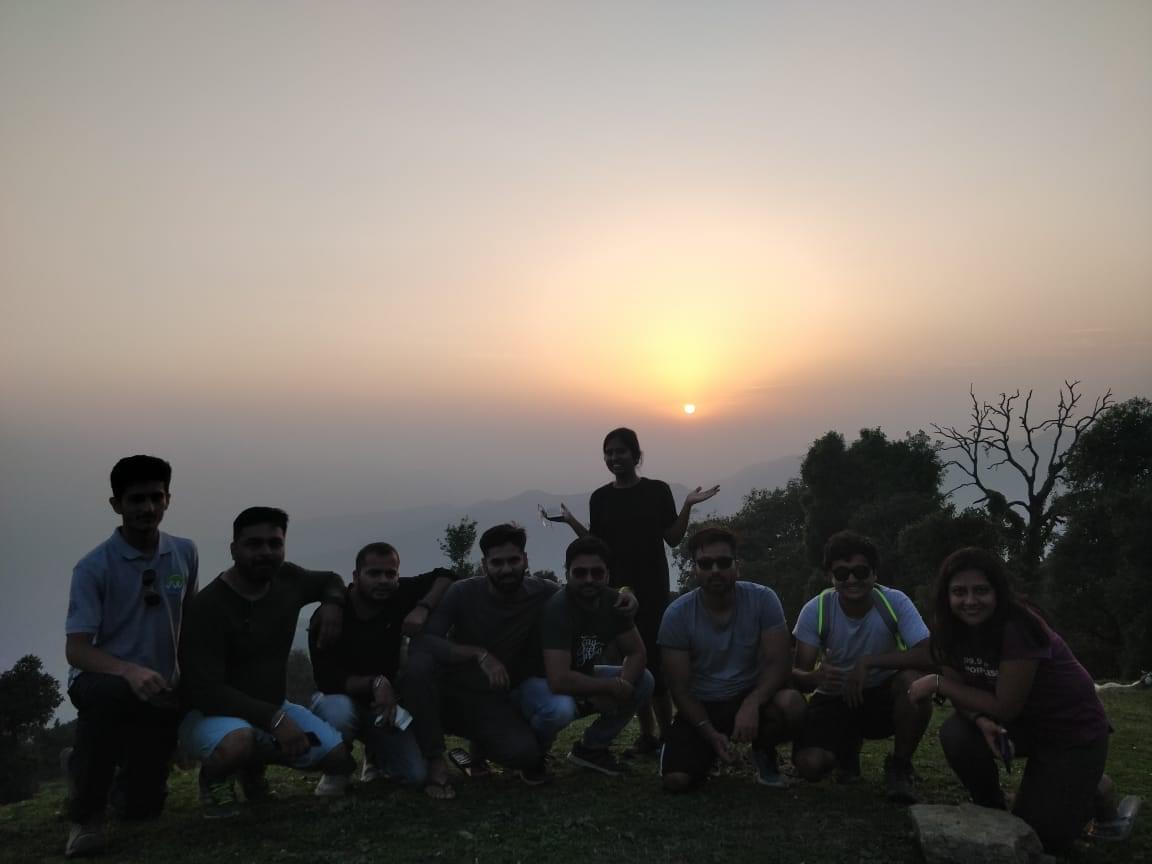
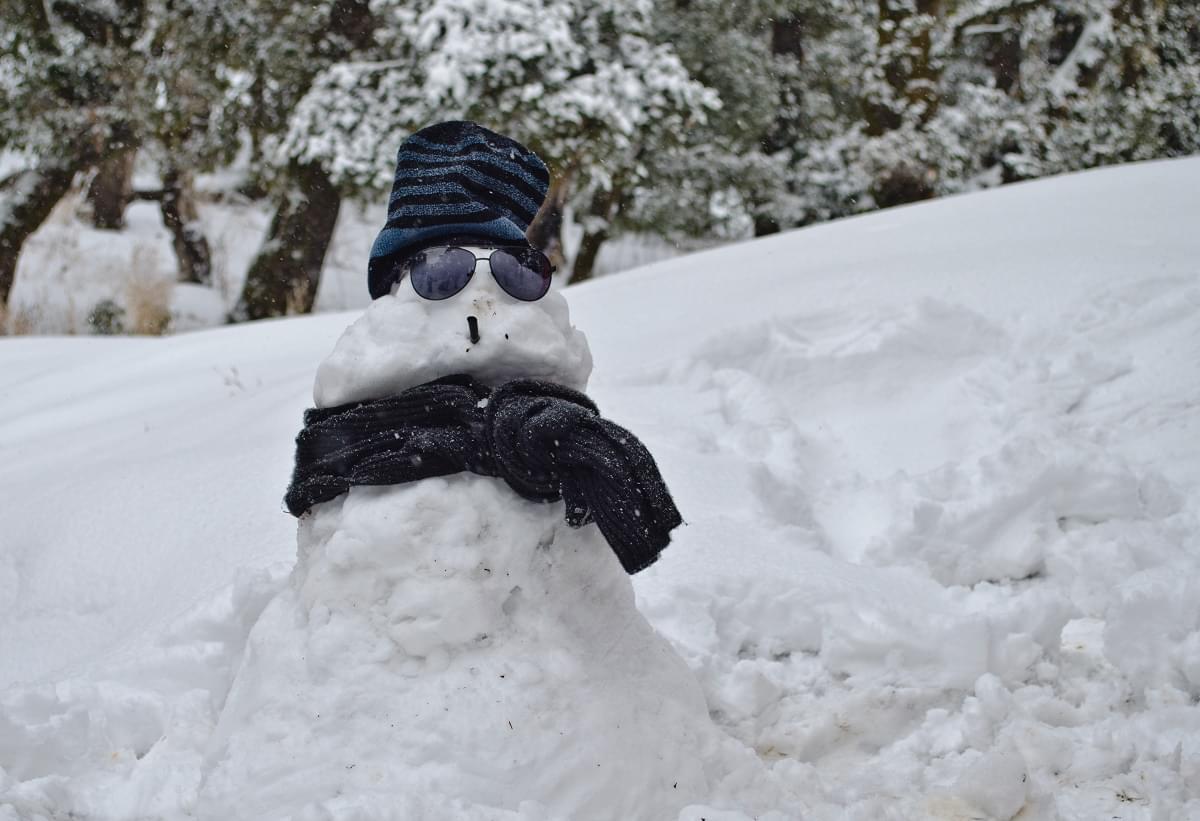
Nag Tibba Trek
Details
Inclusions
Safe Travel
Flexible Cancellation
Easy EMI
Certified Captains
24/7 Support
Overview
One of the best winter treks to do in India, which is best suited for beginners, ends with a rewarding view of the peaks of the great Himalayas and is accessible throughout the year, is the Nag Tibba trek. Situated at an altitude of more than 9000ft above sea level, this trek is perfect for a 3-day weekend trip to the Himalayas. The place holds mythical significance as the word ‘Nag Tibba’ itself means Serpent’s Peak. This part of the Garhwal Himalayan region is influenced by the ‘Nag-Devta’ or Serpent god and is sacred to locals who worship the Serpent god. Especially at the time when they want their Cattle to flourish. If you are staying in Delhi, then you can easily plan the Nag Tibba trek as a weekend getaway. The trail begins from the quaint village of Pantwari and although the terrain isn’t smooth at first, it gradually leads to lush green forests of oak trees relieving you from stress. The trail provides a closer glimpse at the slow-paced life of the mountains where you get to see thatched huts and the quaint life that remains untouched by the hustle and bustle we see in the cities. The best part is during spring, the meadows are covered in different colored blossoms while winters offer a thick carpet of snow for you to walk upon. The great Himalayas in the backdrop beckons you to reach the summit so that you can take in the breathtaking view that comes with the conclusion of the trek. The view of the Gangotri massif, especially when they are covered in an ivory blanket of snow, is to die for.
To make sure that you get to make the most of this escapade to the mountains and make some great memories, we also provide group bonding activities so you can get comfortable with your fellow travelers so that when you think back to this trip, your face instantly lights up with a smile. Although the trek to Nag Tibba is accessible throughout the year, the best time to do the Nag Tibba trek is from October to February especially if you are a snow lover. The Nag Tibba trek should be the one thing you should cross soon from your ‘treks to do in winter list. Nag Tibba trek is famous for camping and as a trekking destination situated in the midst of the Himalayan region. There is also a temple situated at the highest point of the Nag Tibba Summit and the view from there is something you would want to capture for life.
Gallery




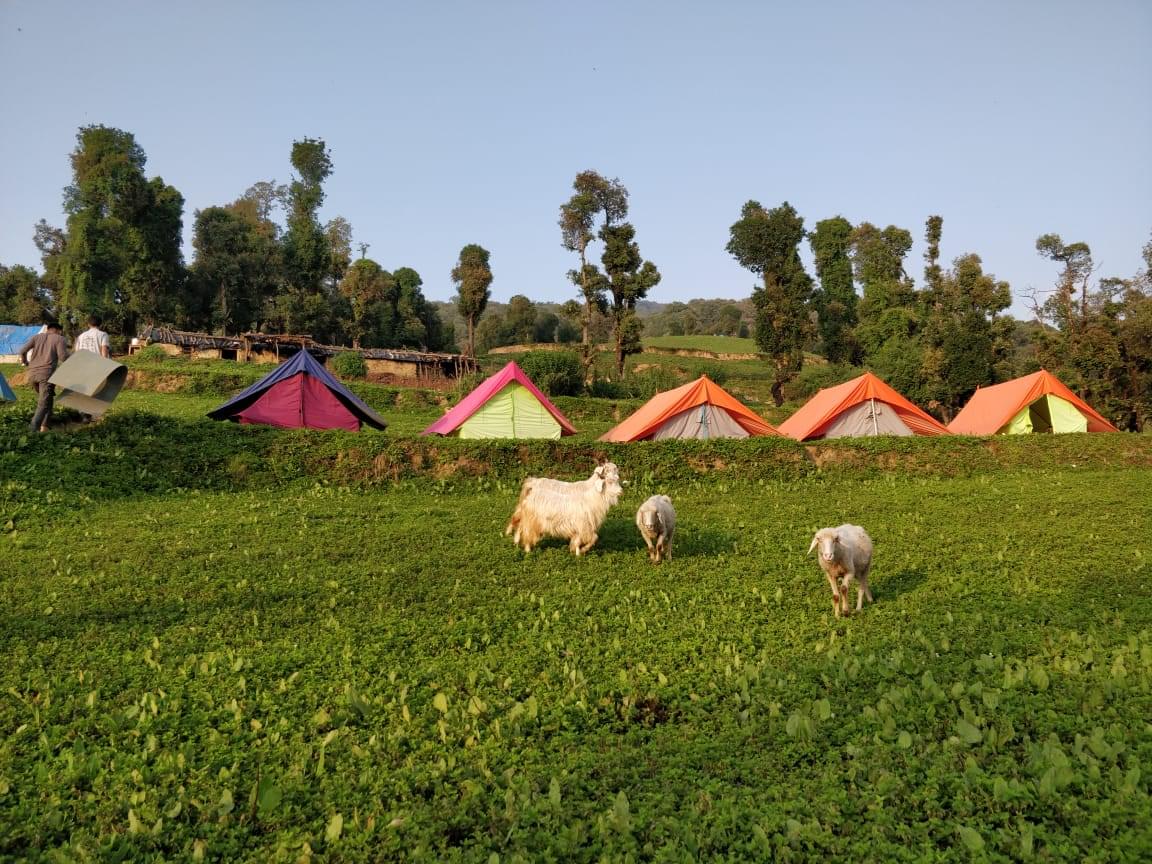
Itinerary
0
Day
Delhi to Pantwari Village (300 Kilometers, 8 Hours)
1
Day
Trek from Pantwari to Nag tibba base camp (6 Kilometers, 4 Hours)
2
Day
Trek to Nag tibba Summit | Back to Pantwari | Departure
3
Day
Delhi Arrival | Trip ends
Age Limit (Trip Wise)
Weekend
Getaways
18-38
Himalayan
Treks
18-48
Backpacking
Trips
18-40
Biking
Trips
18-45
Customized
Trips
No Limit
Inclusions & Exclusions
| Inclusions | Exclusions |
Transportation: Tempo Traveler for Delhi to Delhi transportation Accommodation: 1 Nights Accommodation in camps. Sightseeing as per the Itinerary Meal Plan(Veg): MAPI Plan (Total 4 Meals - 2 Meal on Day 1 (L+D) + 2 Meals on Day 2 (B+L)) Sleeping Bag and Blankets Freshen up space in Pantwari The trip Captain will be present at all times during the tour. First Aid Kits All required Permits Driver Allowance Toll Taxes and other state taxes Parking Charges | 5% GST. Early check-in (Before 1:00 PM) & Late Check-out (After 11:00 AM) at the hotel. Any additional expenses such as of personal nature. Additional accommodation/food costs incurred due to any delayed travel. Any other meals not mentioned in Package Inclusions. Any Airfare/Rail fare other than what is mentioned in “Inclusions”. Parking and monument entry fees during sightseeing. Additional Costs due to Flight Cancellations, Landslides, Roadblocks, and other natural calamities. Any other services not specified above in inclusions. |
Cancellation Policy
| Upto 16 days | 15-8 days | 7-3 days | 2-0 days | |
| Batch Shifting | ||||
| Cancellation Charge | Free Cancellation | 25% of the Trip Amount | 50% of the Trip Amount | 100% of the Trip Amount |
| Booking Amount | Refunded in mode of Credit Note | Adjusted in Refund Deduction | Adjusted in Refund Deduction | No Refund |
| Remaining Amount | Full Refund (minus) booking amount | Refund (minus) 25% of the trip amount | Refund (minus) 50% of the trip amount | No Refund |
Payment Policy
| Upto 16 days | 15-08 days | 07-03 days | 02-0 days | |
|---|---|---|---|---|
| Booking Amount | ||||
| 50% Payment | Optional | Compulsory | ||
| 75% Payment | Optional | Optional | Compulsory | |
| 100% Payment | Optional | Optional | Optional | Compulsory |
Things To Pack
Rucksack:
You must pick a good quality backpack with a comfortable fit and straps that won’t give you shoulder pain. You can check out your nearest Decathlon store for a good trekking backpack.
You must pick a good quality backpack with a comfortable fit and straps that won’t give you shoulder pain. You can check out your nearest Decathlon store for a good trekking backpack.
Day Bag / Day Pack:
When you head towards the summit, you are required to carry only a few necessary items and for that, you need a day backpack as you will leave your bigger one on the campsite.
When you head towards the summit, you are required to carry only a few necessary items and for that, you need a day backpack as you will leave your bigger one on the campsite.
Hiking Shoes :
Durable footwear designed for rugged terrains.
Durable footwear designed for rugged terrains.
Floaters or Sandals:
Although the entire trek requires a good quality shoe, you still need to let your feet breathe to avoid chafing and blisters. When you are at the camp, a good pair of sandals and floaters will help you to move freely.
Although the entire trek requires a good quality shoe, you still need to let your feet breathe to avoid chafing and blisters. When you are at the camp, a good pair of sandals and floaters will help you to move freely.
Tees / Tshirts:
You must keep at least three pairs of quick dry tees so that you can wash them in between stops for proper hygiene.
You must keep at least three pairs of quick dry tees so that you can wash them in between stops for proper hygiene.
Poncho:
A poncho is an evolved form of a raincoat that provides coverage to your body as well as your bag and ensures total water protection from rain.
A poncho is an evolved form of a raincoat that provides coverage to your body as well as your bag and ensures total water protection from rain.
Quick Dry Towel:
A quick dry towel will help in maintaining proper hygiene. It must dry quickly because the wet fabric will only increase the chance of bacterial growth.
A quick dry towel will help in maintaining proper hygiene. It must dry quickly because the wet fabric will only increase the chance of bacterial growth.
Sanitizer:
Essential for maintaining cleanliness while trekking.
Essential for maintaining cleanliness while trekking.
Sun Cap / Hat:
A lightweight sun cap with side flaps is perfect to keep your head cool and avoid sunburns on a sunny day.
A lightweight sun cap with side flaps is perfect to keep your head cool and avoid sunburns on a sunny day.
Sunscreen SPF 40+:
To avoid sunburns and chafing, you need to put on sunscreen as well as cold cream.
To avoid sunburns and chafing, you need to put on sunscreen as well as cold cream.
Water Bottle (Re-usable):
Hydration is extremely important when it comes to trekking. Carrying a water bottle that you can refill with Himalayan water is a must.
Hydration is extremely important when it comes to trekking. Carrying a water bottle that you can refill with Himalayan water is a must.
Personal Toiletries:
A bag with all your essentials including napkins, toothpaste, sanitizers, paper soap, etc should be carried in a ziplock bag.
A bag with all your essentials including napkins, toothpaste, sanitizers, paper soap, etc should be carried in a ziplock bag.
Personal Medication / First Aid:
A few cuts and bruises are almost inevitable when you are on a trek so carrying a medical kit with bandages, Dettol, etc is necessary.
A few cuts and bruises are almost inevitable when you are on a trek so carrying a medical kit with bandages, Dettol, etc is necessary.
Sun Glasses / Reading Glasses:
Photochromatic glasses are specs that are designed to transform into anti-glare shades depending upon exposure to the sun. They are good when it comes to eye protection but one can also opt for clip-on glasses etc.
Photochromatic glasses are specs that are designed to transform into anti-glare shades depending upon exposure to the sun. They are good when it comes to eye protection but one can also opt for clip-on glasses etc.
Charger:
To keep your electronic devices powered during the trip.
To keep your electronic devices powered during the trip.
Power Bank:
Ensures your devices stay charged when there are no outlets.
Ensures your devices stay charged when there are no outlets.
Personal Documents & ID's:
Identification proofs like Aadhar Card, Drivers License.
Identification proofs like Aadhar Card, Drivers License.
Laundry Bag (Waterproof):
In case your clothes get wet or your garments don’t dry, you can carry them in polythene. However, make sure that all the plastic that you are carrying into the woods leaves with you. Don’t litter in the mountains.
In case your clothes get wet or your garments don’t dry, you can carry them in polythene. However, make sure that all the plastic that you are carrying into the woods leaves with you. Don’t litter in the mountains.
Track Pants:
A good pair of track pants made of polyester will let your skin breathe. They’re lightweight, dry easily, and comfortable to walk around in. You can easily avoid chafing and rashes by investing in a good pair of track pants.
A good pair of track pants made of polyester will let your skin breathe. They’re lightweight, dry easily, and comfortable to walk around in. You can easily avoid chafing and rashes by investing in a good pair of track pants.
Trekking Shoes:
A good trekking shoe is comfortable, provides ankle support, and has a good grip as well. They shouldn’t be chunky, instead, they should be lightweight and sturdy.
A good trekking shoe is comfortable, provides ankle support, and has a good grip as well. They shouldn’t be chunky, instead, they should be lightweight and sturdy.
Cotton Socks:
Cotton socks are extremely comfortable to move around in and are lightweight as well which is why you can always count on a good pair of cotton socks while trekking. However, keep in mind to change them and avoid wearing them when they are wet.
Cotton socks are extremely comfortable to move around in and are lightweight as well which is why you can always count on a good pair of cotton socks while trekking. However, keep in mind to change them and avoid wearing them when they are wet.
Woolen Socks:
A good pair of woolen socks, especially merino, are comfortable, limit odors and provide adequate insulation from the cold so you can wear them at night.
A good pair of woolen socks, especially merino, are comfortable, limit odors and provide adequate insulation from the cold so you can wear them at night.
Woolen Gloves:
Insulated gloves help in maintaining proper body heat in your hands and also provide a better grasp on trekking poles.
Insulated gloves help in maintaining proper body heat in your hands and also provide a better grasp on trekking poles.
Main Jacket:
It’s emphasized that you need to carry proper layers so you can avoid getting cold which is why you need to carry a heavy jacket that you can put on over your other clothes.
It’s emphasized that you need to carry proper layers so you can avoid getting cold which is why you need to carry a heavy jacket that you can put on over your other clothes.
Woolen Cap:
A woolen cap will help prevent cold when you ascend to high altitude. You can also cover your ears to avoid any pain and discomfort you might face in them when going at high altitudes.
A woolen cap will help prevent cold when you ascend to high altitude. You can also cover your ears to avoid any pain and discomfort you might face in them when going at high altitudes.
Hoodie:
A versatile layering option for various temperatures.
A versatile layering option for various temperatures.
Scarf / Balaclava:
Along with sun rays and chilly winds, you also get hit by dirt and grime during treks which is why it's important to carry a scarf or balaclava so you can cover your face when needed.
Along with sun rays and chilly winds, you also get hit by dirt and grime during treks which is why it's important to carry a scarf or balaclava so you can cover your face when needed.
Head Lamp:
You can’t rely on moonlight when you are in the mountains. A torch or even a headlamp with a fresh pair of batteries is always a good idea to bring along.
You can’t rely on moonlight when you are in the mountains. A torch or even a headlamp with a fresh pair of batteries is always a good idea to bring along.
Trekking Pole:
The trekking pole assists in more than one way. It saves energy while also providing stability and helps you to maintain proper balance.
The trekking pole assists in more than one way. It saves energy while also providing stability and helps you to maintain proper balance.
Camera:
This should be obvious. To make sure that you get to capture all the great moments from your trek. Make sure that you have enough storage and some extra batteries as well.
This should be obvious. To make sure that you get to capture all the great moments from your trek. Make sure that you have enough storage and some extra batteries as well.
Riding Gear:
If your trip involves biking or motorcycling.
If your trip involves biking or motorcycling.
Moisturiser & Cold Cream:
To avoid sunburns and chafing, you need to put on sunscreen as well as cold cream.
To avoid sunburns and chafing, you need to put on sunscreen as well as cold cream.
Lip Balm:
Your lips can become chapped due to the harsh cold winds so it's important to keep them moisturized.
Your lips can become chapped due to the harsh cold winds so it's important to keep them moisturized.
Sanitary Pads:
Essential for feminine hygiene.
Essential for feminine hygiene.
Insect Repellent:
Guards against pesky bugs and insects.
Guards against pesky bugs and insects.
Cash:
Emergency funds for unexpected situations.
Emergency funds for unexpected situations.
Thermals:
Thermal is a piece of garment that helps in keeping your body warm in cold temperatures. It is a necessary item that you need when going on a high-altitude trek.
Thermal is a piece of garment that helps in keeping your body warm in cold temperatures. It is a necessary item that you need when going on a high-altitude trek.
Snacks / Dryfruits / Energy Bar:
Provides quick energy on the go.
Provides quick energy on the go.
Positive Attitude:
The most important item for a successful trek or trip, keeping your spirits high and adaptable to the challenges of the journey.
The most important item for a successful trek or trip, keeping your spirits high and adaptable to the challenges of the journey.
REVIEWS
What our Clients Say About Us
blogs
Our Blogs
Faq
Have any Doubts
How to prepare for the Nag Tibba trek?
The Nag Tibba trek is an easy trek and doesn't require extensive exercise. Regular jogging and sprinting for 30 mins a few weeks before will build the required endurance.
What is the best time to do the Nag Tibba trek?
Depending on the kind of landscape you enjoy the most, you can embark on the Nag Tibba trek throughout the year during different months. The best time to undertake the Nag Tibba Trek in the summer season is the months from April to June.
For the onset of the winter season, the best time would be from October to December.
For travelers who would love to experience snowfall or snow trekking, the best months to do the Nag Tibba trek would be from January to March.
Is there network in Nag Tibba?
Airtel, Jio, Idea, and BSNL get decent networks up until the Kathian campsite. There might be some network issues around the summit.
When does it snow at Nag Tibba?
The temperature remains pleasant throughout the year in the region with snowfall covering the higher peaks of Nag Tibba from the month of January to March.
How long is the Nag Tibba Trek?
The Nag Tibba trek stretches up to 8 Kilometers long trail and takes 5-6 hours to complete.
What is the basecamp for the Nag Tibba Trek?
The Nag Tibba starts from Pantwari village which is approximately 85 Kilometers away from Dehradun.
Where is Nag Tibba located?
At an elevation of 3,022 meters, Nag Tibba is the highest peak in the lower Himalayas of Uttarakhand and falls under the Tehri Garwhal district of Uttarakhand.
How difficult is the Nag Tibba Trek?
The Nag Tibba Trek falls under the easy-to-moderate category when it comes to the difficulty level and can be attempted by people with no prior trekking experience.
How many days are required for the Nag Tibba trek?
The trail of the Nag Tibba trek stretches up to 16 Kilometers with gradual ascents. Two days are enough for the Nag Tibba trek. You can trek to the campsite on day one and cover the rest of the distance to the Nag Tibba summit on the second day. You can enjoy the view of Trishul, Swargrohini, Bandarpoonch, and other majestic Himalayan peaks without getting exhausted.
What services are included in this itinerary of the Nag Tibba Trek?
On our Nag Tibba trek itinerary, we provide accommodation in camps, transportation, surface transfer wherever possible, and meals as per the itinerary. Along with that, an experienced trip leader equipped with a medical kit always stays with the group. All kinds of permits, toll taxes, parking charges, and driver allowances are also included.
What are some things to pack for the Nag Tibba trek?
Depending on the destination that you are traveling to, we share an extensive list of things you need to carry on your trips. Some of the essentials that you must carry are your documents (ID proof, Drivers license, etc), a medical kit with all your personal medications and medicines for nausea, headache, etc as well.
What is the booking process for the Nag Tibba trek?
You can book the trip from the website by clicking on the “Book Now” button. After that, you just have to fill in the necessary details like the batch dates, occupancy, and more. You can apply coupons or redeem your gift card to get discounts during the process.
You can either pay just the booking amount or the entire price depending on your convenience. We also have Pay-Later and EMI options.
Our payment gateway options include UPI, Netbanking, Debit Cards, EMI, Mobile Wallets, and more.
TRIPS
Related Trips





Nag Tibba Trek
Details
Inclusions
Safe Travel
Flexible Cancellation
Easy EMI
Certified Captains
24/7 Support
Overview
One of the best winter treks to do in India, which is best suited for beginners, ends with a rewarding view of the peaks of the great Himalayas and is accessible throughout the year, is the Nag Tibba trek. Situated at an altitude of more than 9000ft above sea level, this trek is perfect for a 3-day weekend trip to the Himalayas. The place holds mythical significance as the word ‘Nag Tibba’ itself means Serpent’s Peak. This part of the Garhwal Himalayan region is influenced by the ‘Nag-Devta’ or Serpent god and is sacred to locals who worship the Serpent god. Especially at the time when they want their Cattle to flourish. If you are staying in Delhi, then you can easily plan the Nag Tibba trek as a weekend getaway. The trail begins from the quaint village of Pantwari and although the terrain isn’t smooth at first, it gradually leads to lush green forests of oak trees relieving you from stress. The trail provides a closer glimpse at the slow-paced life of the mountains where you get to see thatched huts and the quaint life that remains untouched by the hustle and bustle we see in the cities. The best part is during spring, the meadows are covered in different colored blossoms while winters offer a thick carpet of snow for you to walk upon. The great Himalayas in the backdrop beckons you to reach the summit so that you can take in the breathtaking view that comes with the conclusion of the trek. The view of the Gangotri massif, especially when they are covered in an ivory blanket of snow, is to die for.
To make sure that you get to make the most of this escapade to the mountains and make some great memories, we also provide group bonding activities so you can get comfortable with your fellow travelers so that when you think back to this trip, your face instantly lights up with a smile. Although the trek to Nag Tibba is accessible throughout the year, the best time to do the Nag Tibba trek is from October to February especially if you are a snow lover. The Nag Tibba trek should be the one thing you should cross soon from your ‘treks to do in winter list. Nag Tibba trek is famous for camping and as a trekking destination situated in the midst of the Himalayan region. There is also a temple situated at the highest point of the Nag Tibba Summit and the view from there is something you would want to capture for life.
Itinerary
0
Day
Delhi to Pantwari Village (300 Kilometers, 8 Hours)
1
Day
Trek from Pantwari to Nag tibba base camp (6 Kilometers, 4 Hours)
2
Day
Trek to Nag tibba Summit | Back to Pantwari | Departure
3
Day
Delhi Arrival | Trip ends
Age Limit (Trip Wise)
Weekend
Getaways
18-38
Himalayan
Treks
18-48
Backpacking
Trips
18-40
Biking
Trips
18-45
Customized
Trips
No Limit
Pricing
Select Occupancy
+5% GST *
Batches
Transportation: Tempo Traveler for Delhi to Delhi transportation Accommodation: 1 Nights Accommodation in camps. Sightseeing as per the Itinerary Meal Plan(Veg): MAPI Plan (Total 4 Meals - 2 Meal on Day 1 (L+D) + 2 Meals on Day 2 (B+L)) Sleeping Bag and Blankets Freshen up space in Pantwari The trip Captain will be present at all times during the tour. First Aid Kits All required Permits Driver Allowance Toll Taxes and other state taxes Parking Charges |
Cancellation Policy
Credit Note :
The Booking Amount will be credited to your JW Profile which can be accessed by logging in to the website through your Email ID. Credit Notes issued have no date of expiry and can be used entirely in any of your future trips.
GST :
The Booking Amount will be credited to your JW Profile which can be accessed by logging in to the website through your Email ID. Credit Notes issued have no date of expiry and can be used entirely in any of your future trips.
Payment Policy
Things To Pack
Rucksack:
You must pick a good quality backpack with a comfortable fit and straps that won’t give you shoulder pain. You can check out your nearest Decathlon store for a good trekking backpack.
You must pick a good quality backpack with a comfortable fit and straps that won’t give you shoulder pain. You can check out your nearest Decathlon store for a good trekking backpack.
Day Bag / Day Pack:
When you head towards the summit, you are required to carry only a few necessary items and for that, you need a day backpack as you will leave your bigger one on the campsite.
When you head towards the summit, you are required to carry only a few necessary items and for that, you need a day backpack as you will leave your bigger one on the campsite.
Hiking Shoes :
Durable footwear designed for rugged terrains.
Durable footwear designed for rugged terrains.
Floaters or Sandals:
Although the entire trek requires a good quality shoe, you still need to let your feet breathe to avoid chafing and blisters. When you are at the camp, a good pair of sandals and floaters will help you to move freely.
Although the entire trek requires a good quality shoe, you still need to let your feet breathe to avoid chafing and blisters. When you are at the camp, a good pair of sandals and floaters will help you to move freely.
Tees / Tshirts:
You must keep at least three pairs of quick dry tees so that you can wash them in between stops for proper hygiene.
You must keep at least three pairs of quick dry tees so that you can wash them in between stops for proper hygiene.
Poncho:
A poncho is an evolved form of a raincoat that provides coverage to your body as well as your bag and ensures total water protection from rain.
A poncho is an evolved form of a raincoat that provides coverage to your body as well as your bag and ensures total water protection from rain.
Quick Dry Towel:
A quick dry towel will help in maintaining proper hygiene. It must dry quickly because the wet fabric will only increase the chance of bacterial growth.
A quick dry towel will help in maintaining proper hygiene. It must dry quickly because the wet fabric will only increase the chance of bacterial growth.
Sanitizer:
Essential for maintaining cleanliness while trekking.
Essential for maintaining cleanliness while trekking.
Sun Cap / Hat:
A lightweight sun cap with side flaps is perfect to keep your head cool and avoid sunburns on a sunny day.
A lightweight sun cap with side flaps is perfect to keep your head cool and avoid sunburns on a sunny day.
Sunscreen SPF 40+:
To avoid sunburns and chafing, you need to put on sunscreen as well as cold cream.
To avoid sunburns and chafing, you need to put on sunscreen as well as cold cream.
Water Bottle (Re-usable):
Hydration is extremely important when it comes to trekking. Carrying a water bottle that you can refill with Himalayan water is a must.
Hydration is extremely important when it comes to trekking. Carrying a water bottle that you can refill with Himalayan water is a must.
Personal Toiletries:
A bag with all your essentials including napkins, toothpaste, sanitizers, paper soap, etc should be carried in a ziplock bag.
A bag with all your essentials including napkins, toothpaste, sanitizers, paper soap, etc should be carried in a ziplock bag.
Personal Medication / First Aid:
A few cuts and bruises are almost inevitable when you are on a trek so carrying a medical kit with bandages, Dettol, etc is necessary.
A few cuts and bruises are almost inevitable when you are on a trek so carrying a medical kit with bandages, Dettol, etc is necessary.
Sun Glasses / Reading Glasses:
Photochromatic glasses are specs that are designed to transform into anti-glare shades depending upon exposure to the sun. They are good when it comes to eye protection but one can also opt for clip-on glasses etc.
Photochromatic glasses are specs that are designed to transform into anti-glare shades depending upon exposure to the sun. They are good when it comes to eye protection but one can also opt for clip-on glasses etc.
Charger:
To keep your electronic devices powered during the trip.
To keep your electronic devices powered during the trip.
Power Bank:
Ensures your devices stay charged when there are no outlets.
Ensures your devices stay charged when there are no outlets.
Personal Documents & ID's:
Identification proofs like Aadhar Card, Drivers License.
Identification proofs like Aadhar Card, Drivers License.
Laundry Bag (Waterproof):
In case your clothes get wet or your garments don’t dry, you can carry them in polythene. However, make sure that all the plastic that you are carrying into the woods leaves with you. Don’t litter in the mountains.
In case your clothes get wet or your garments don’t dry, you can carry them in polythene. However, make sure that all the plastic that you are carrying into the woods leaves with you. Don’t litter in the mountains.
Track Pants:
A good pair of track pants made of polyester will let your skin breathe. They’re lightweight, dry easily, and comfortable to walk around in. You can easily avoid chafing and rashes by investing in a good pair of track pants.
A good pair of track pants made of polyester will let your skin breathe. They’re lightweight, dry easily, and comfortable to walk around in. You can easily avoid chafing and rashes by investing in a good pair of track pants.
Trekking Shoes:
A good trekking shoe is comfortable, provides ankle support, and has a good grip as well. They shouldn’t be chunky, instead, they should be lightweight and sturdy.
A good trekking shoe is comfortable, provides ankle support, and has a good grip as well. They shouldn’t be chunky, instead, they should be lightweight and sturdy.
Cotton Socks:
Cotton socks are extremely comfortable to move around in and are lightweight as well which is why you can always count on a good pair of cotton socks while trekking. However, keep in mind to change them and avoid wearing them when they are wet.
Cotton socks are extremely comfortable to move around in and are lightweight as well which is why you can always count on a good pair of cotton socks while trekking. However, keep in mind to change them and avoid wearing them when they are wet.
Woolen Socks:
A good pair of woolen socks, especially merino, are comfortable, limit odors and provide adequate insulation from the cold so you can wear them at night.
A good pair of woolen socks, especially merino, are comfortable, limit odors and provide adequate insulation from the cold so you can wear them at night.
Woolen Gloves:
Insulated gloves help in maintaining proper body heat in your hands and also provide a better grasp on trekking poles.
Insulated gloves help in maintaining proper body heat in your hands and also provide a better grasp on trekking poles.
Main Jacket:
It’s emphasized that you need to carry proper layers so you can avoid getting cold which is why you need to carry a heavy jacket that you can put on over your other clothes.
It’s emphasized that you need to carry proper layers so you can avoid getting cold which is why you need to carry a heavy jacket that you can put on over your other clothes.
Woolen Cap:
A woolen cap will help prevent cold when you ascend to high altitude. You can also cover your ears to avoid any pain and discomfort you might face in them when going at high altitudes.
A woolen cap will help prevent cold when you ascend to high altitude. You can also cover your ears to avoid any pain and discomfort you might face in them when going at high altitudes.
Hoodie:
A versatile layering option for various temperatures.
A versatile layering option for various temperatures.
Scarf / Balaclava:
Along with sun rays and chilly winds, you also get hit by dirt and grime during treks which is why it's important to carry a scarf or balaclava so you can cover your face when needed.
Along with sun rays and chilly winds, you also get hit by dirt and grime during treks which is why it's important to carry a scarf or balaclava so you can cover your face when needed.
Head Lamp:
You can’t rely on moonlight when you are in the mountains. A torch or even a headlamp with a fresh pair of batteries is always a good idea to bring along.
You can’t rely on moonlight when you are in the mountains. A torch or even a headlamp with a fresh pair of batteries is always a good idea to bring along.
Trekking Pole:
The trekking pole assists in more than one way. It saves energy while also providing stability and helps you to maintain proper balance.
The trekking pole assists in more than one way. It saves energy while also providing stability and helps you to maintain proper balance.
Camera:
This should be obvious. To make sure that you get to capture all the great moments from your trek. Make sure that you have enough storage and some extra batteries as well.
This should be obvious. To make sure that you get to capture all the great moments from your trek. Make sure that you have enough storage and some extra batteries as well.
Riding Gear:
If your trip involves biking or motorcycling.
If your trip involves biking or motorcycling.
Moisturiser & Cold Cream:
To avoid sunburns and chafing, you need to put on sunscreen as well as cold cream.
To avoid sunburns and chafing, you need to put on sunscreen as well as cold cream.
Lip Balm:
Your lips can become chapped due to the harsh cold winds so it's important to keep them moisturized.
Your lips can become chapped due to the harsh cold winds so it's important to keep them moisturized.
Sanitary Pads:
Essential for feminine hygiene.
Essential for feminine hygiene.
Insect Repellent:
Guards against pesky bugs and insects.
Guards against pesky bugs and insects.
Cash:
Emergency funds for unexpected situations.
Emergency funds for unexpected situations.
Thermals:
Thermal is a piece of garment that helps in keeping your body warm in cold temperatures. It is a necessary item that you need when going on a high-altitude trek.
Thermal is a piece of garment that helps in keeping your body warm in cold temperatures. It is a necessary item that you need when going on a high-altitude trek.
Snacks / Dryfruits / Energy Bar:
Provides quick energy on the go.
Provides quick energy on the go.
Positive Attitude:
The most important item for a successful trek or trip, keeping your spirits high and adaptable to the challenges of the journey.
The most important item for a successful trek or trip, keeping your spirits high and adaptable to the challenges of the journey.
Similar Packages
REVIEWS
What our Clients Say About Us
blogs
Our Blogs
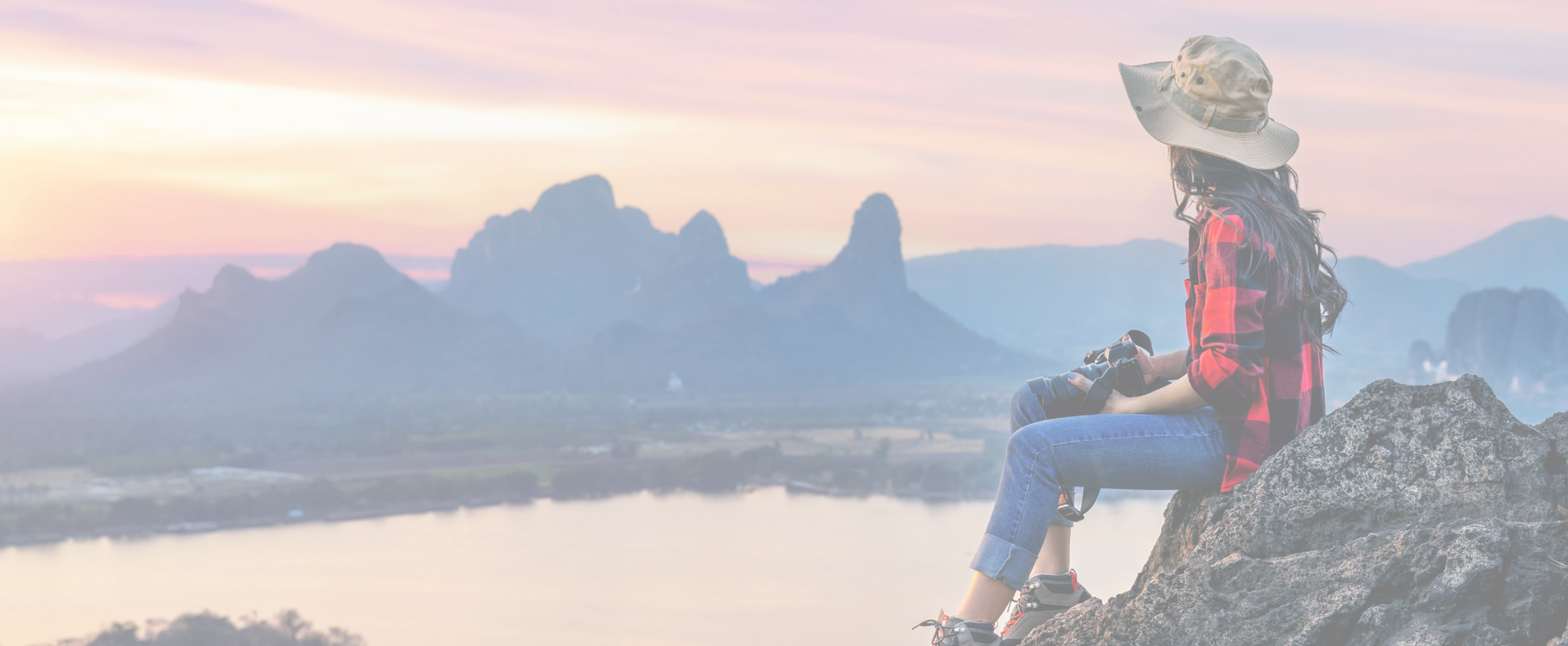
Newsletter
Sign up now!
Be the first one to know all about the Exciting Offers, Travel Updates and more.
Group Tours
Customized Trips
Contact Us
B-42, 2nd Floor, Tower- B,
The Corenthum, Block A, Sector 62, Noida, Uttar Pradesh 201301
© 2015-2024 JustWravel Pvt. Ltd.
Starts From


